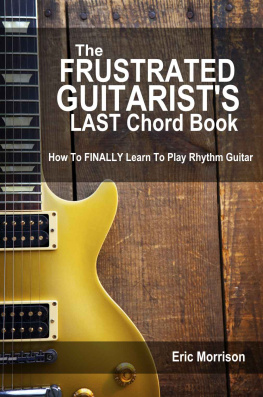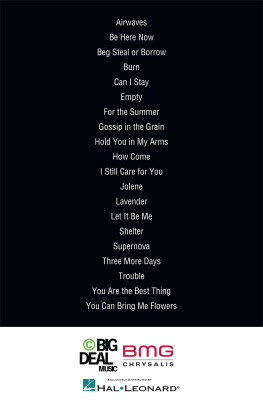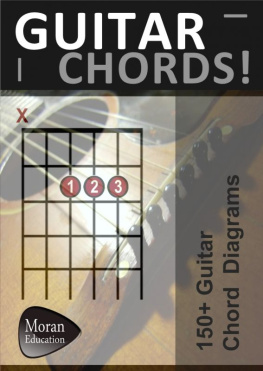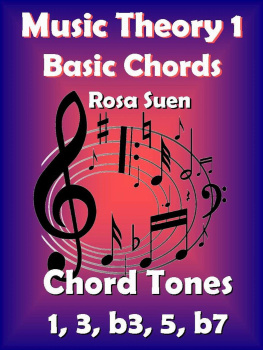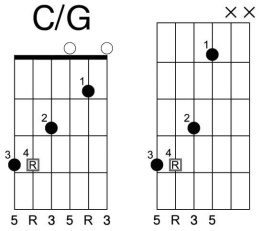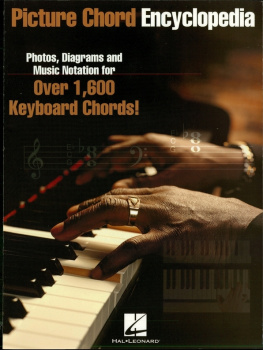The Frustrated Guitarists LAST Chord Book:
How to FINALLY learn to play Rhythm Guitar!
Eric J. Morrison
Copyright 2012 by Eric J. Morrison
All rights reserved
Second Edition
Table of Contents:
1. Introduction:
Welcome to The Frustrated Guitarists LAST Chord Book !
Thank you very much for your purchase.
This book is a new entity on the playing field of guitar instruction. However, I firmly believe that, as of this writing, there is no finer program out there for getting your playing off the ground and then taking it to new and unanticipated heights.
While not truly a chord book in the traditional sense, this book represents a superior system of organizing chords into a logical chord method which facilitates a broader ability for the student to actually memorize the entire fretboard and the chords which can be found within this structure.
This method will focus on the efficiency of two elements of guitar study speed and content . By speed I mean the rate at which information is digested and, most importantly, understood by the student. Content refers to an introduction of the information beginning guitarists need that is formatted in a revolutionary chronology of concepts.
I have not seen the equal to this program anywhere. There are enough guitar method books out there that, if all of them were ignited at once, the blaze would be sufficient to warm a small country into the next decade. I exaggerate, but, not by much.
The question is do any of them have any thing new to say. Probably not. And I dont really claim to either. But, I will take an old idea and organize it into a "new" way of finally seeing the point. That "point" is the key to knowing how to access huge numbers of chords on the guitar.
All that this program - and future volumes on the topic of chord study - are designed to do is intelligently break down and introduce topics to students as they are ready for them . The problem that I see with method books out there is there is way too much focus on creating an all-in-one volume. Occasionally an author will divide their work into two or so volumes. However, in the quest to cram everything from tuning the guitar all the way up to improvising a solo into one book, the student is typically alienated from thorough, practical explanations of concepts at the hands of the editor. There is simply too much information that needs to be absorbed by students in order for them to become complete players than what can be stuffed into one book. There will be gaps. I know from experience that there is nothing more frustrating than a concept in a guitar instructional book (or DVD or online lesson site, etc) that is not sufficiently explained. Your learning stops right there. Until you find another resource that can provide a better explanation for the concept, you are in guitar limbo.
I spent way too much of my early career in long periods of limbo, while waiting to learn my next topic.
By the end of this book you will be a rhythm guitar player .
You will be in demand on the music scene because of your ability to locate just about any chord at will on the fretboard. You will be able to offer your band mates any number of chord voicings up and down the fretboard for any chord theyll ask you to play.
Rhythm playing is what makes the music. There are many professional guitarists that have built entire careers exclusively on rhythm playing.
The alter ego, if you will, to these rhythm players are the flashy and exciting lead players. These guys rely heavily on rhythm guitarists to lay down a musical bed for them to solo over the top of. Without this framework in place courtesy of the rhythm player, there would be no availability for the lead player to show their stuff.
Lead players are advanced in their learning and typically have a thorough grasp of music theory. They must have a strong knowledge of the intricate and seemingly endless combinations of notes within scales and modes that can be played over any given chord progression.
Or they must have a good ear.
Jimi Hendrix is a prime example of a lead guitarist that could play by feel or by ear rather than by a set of rigid rules. His playing did follow the rules but he arrived at note selection differently than other guitarists. Jimi isnt reported to have had any significant musical instruction during his early career and it is therefore assumed that he is self-taught. It is commonly held that he also had no ability to read music. Therefore, in figuring out what notes to play for each chord or solo, it would seem that the rule was, if it sounded good to Jimi, it was O.K.
Have you ever heard a solo played by Jimi Hendrix? His solos display a mastery of technique and ability and a sense of musicality that is unparalleled in modern music.
Now, I am not saying that, if you have a good ear for music, you should abandon your studies and become the next Jimi. But, I will say that an ear for music will help you in your learning immeasurably. A good ear cant be taught. You either have one or you dont. Does this mean that if you dont have a good ear that you are out of luck in ever learning to play lead guitar? Not at all. Whatever the current state of your ear for music, it can be developed and strengthened through repetition. The more you hear music that is following the rules while you are playing, the more you will come to recognize what will or will not work musically.
But this is nothing to worry about right now. Right now we are on to creating a rhythm player.
Rhythm playing does not have the glamorous persona attached to it that lead playing does. However, no lead player ever got to where he is without first acquiring a thorough knowledge of rhythm playing (or, more accurately, chord playing). The two are dependent on each other but chord playing is the bridge a student will need in order to cross over into the land of lead playing. It is never the other way around.
Lets get started!
2. Familiarizing Yourself With The Fretboard:

Pictured above is a guitar fretboard.
It should not strike fear in your heart to view this image. If it does, then it is my goal that we will conquer your fears of the fretboard by the end of this book.
I plan to give you a working knowledge of chords and their formation without bogging you down with a lot of technical jargon about how and why chords are formed in the manner in which they are. I am intentionally withholding much information in the hope that the absence of information will keep your mind from overload.
I wish to concentrate on small successes.
I endeavor to get you actually playing your instrument at the earliest possible stage in your learning process. It could be tonight
Maybe next week. But, you wont give up. Lets take a look at some basic ideas.
First, I assume that as you read this you have a guitar (of some sort) tuned up and ready to go. If you dont know what it means to tune your instrument, let me give you a very brief primer
If you take a look at the picture above, you will see that there are six strings stretched across the fretboard. The topmost string in the picture is of a thinner gauge than the string pictured at the bottom of the fretboard. The view of this fretboard is as if you had strapped on a guitar, tilted it up toward you and were looking down on it. (It would be a mirror image if you are left-handed.) Each string has to be tensioned to a certain point so that, when struck, its vibrations will produce the frequency that corresponds to the desired note of the chosen tuning format.
You will need to become familiar with tuning. If you are using an acoustic guitar, purchase a tuner that recognizes audible notes. There are some that clamp onto the guitar leaving both of your hands free for the task of tuning. If you have an electric guitar, you will usually use a tuner that has an input jack. This is where you connect it to your guitar with an instrument cable. If you find a tuner that has both an input and an output, this type may be ran inline from your guitar to your amp. You will not have to unplug anything to tune up. This is great for long practice sessions where you may need to check your tuning several times. However, most smartphones have tons of free tuning apps available these days which rival expensive tuners. They all rely on audible notes. You may have to put up with ads but we're talking about tuning your guitar here. You could probably live with the ads long enough to get tuned up.
Next page
